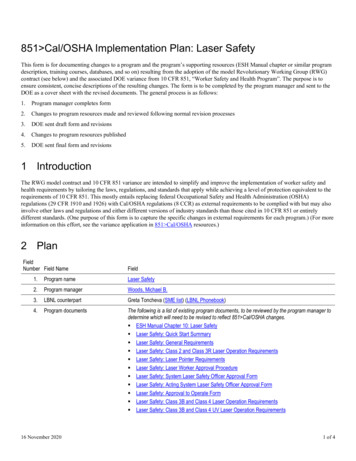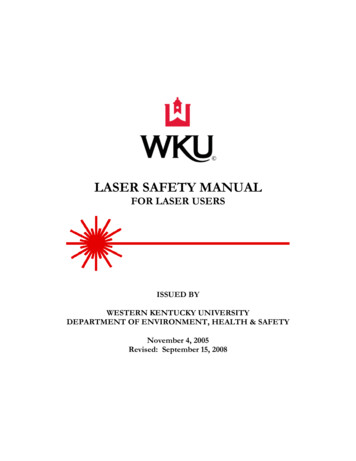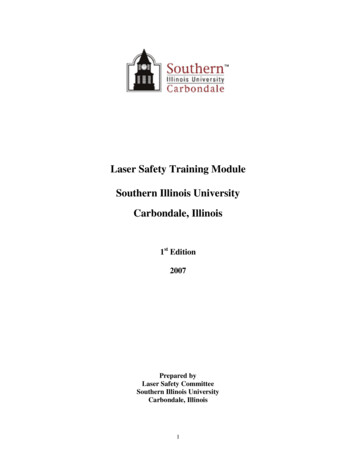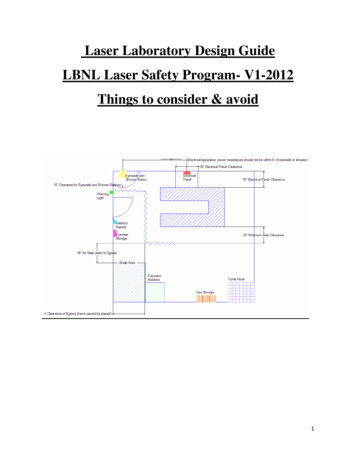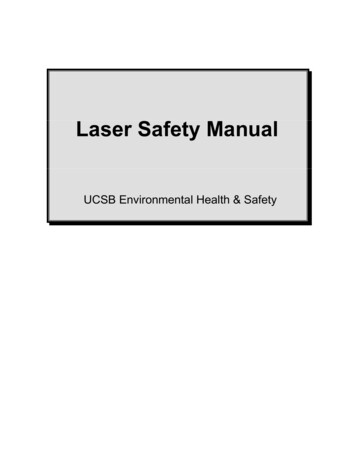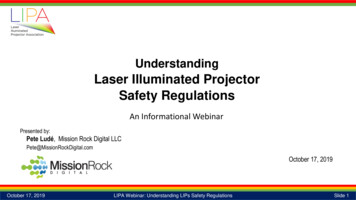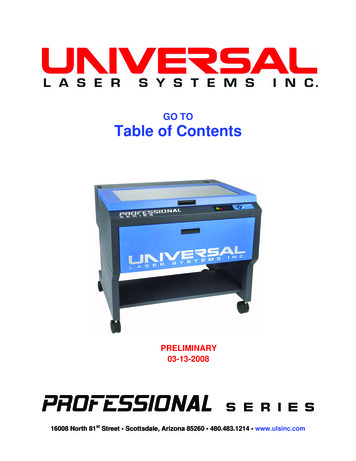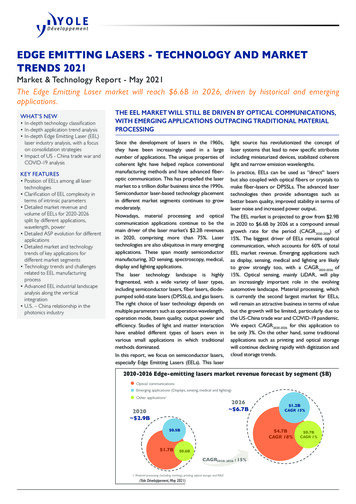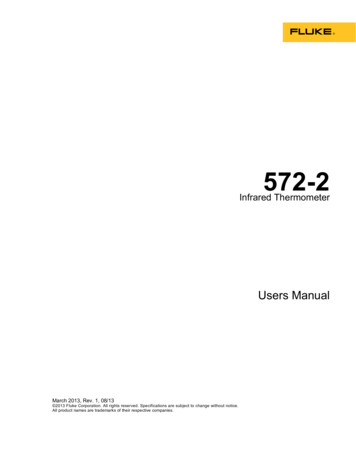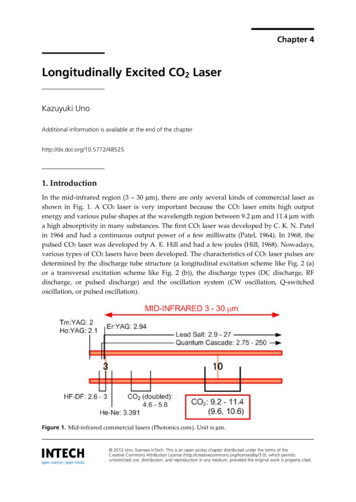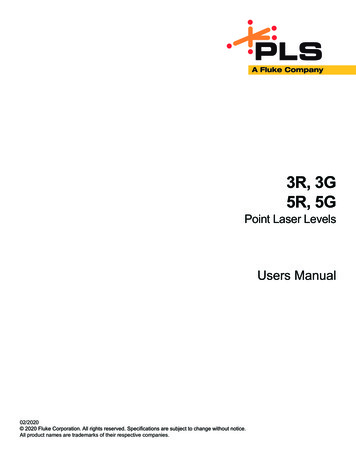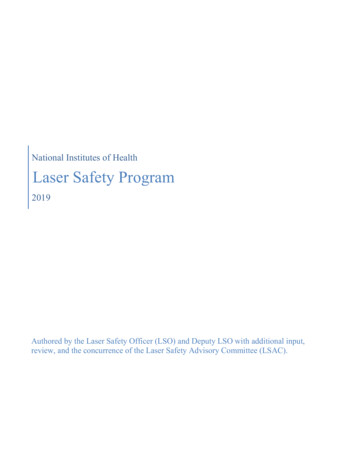
Transcription
National Institutes of HealthLaser Safety Program2019Authored by the Laser Safety Officer (LSO) and Deputy LSO with additional input,review, and the concurrence of the Laser Safety Advisory Committee (LSAC).
CONTENTSINTRODUCTION 2I.PURPOSE 2II.SCOPE . 2III.RESPONSIBILITIES . 2IV.DEFINITIONS . . . 3V.PROGRAM . . . 6VI.REFERENCES . . . 10VII.APPENDICES . . . ion of Occupational Health and SafetyDeputy Laser Safety OfficerLaser Controlled AreaLaser Safety Advisory CommitteeLaser Safety OfficerNational Institutes of HealthOccupational Medical ServiceOffice of Research ServicesPrincipal InvestigatorStandard Operating ProcedureTechnical Assistance Branch1
INTRODUCTIONOver time, the applications for lasers in biomedical research and in clinical treatments havegrown exponentially. This spectrum is on display at NIH, with lasers in use from opticalimaging, where super-resolution microscopy can pinpoint single molecules, to laser therapies ofthe eye, where laser treatments may help reduce the probability of vision loss in some patients.As the number of novel techniques involving lasers grows, so too does the number of personnelwho work directly with or around lasers; the majority of institutes at NIH use lasers. Fullrealization of the benefits of lasers necessitates their safe use by everyone.I.PURPOSEThe Laser Safety Program (LSP) has been developed to provide guidance and oversight for thesafe use of lasers at NIH.II.SCOPEThe LSP applies to all NIH employees, contractors and students working directly with oraround Class 3B and Class 4 lasers and laser systems at official NIH facilities, hereinafterreferred to as lasers.III.RESPONSIBILITIESLaser Safety Advisory Committee (LSAC):a) Develop and manage the LSP;b) Verify safety practices and control methods by personnel using lasers;c) Investigate all incidents and accidents involving the use of lasers in NIH facilities; andd) Maintain an accurate inventory of lasers.Laser Safety Officer (LSO):a) Assist with laser hazard evaluation and classification;b) Provide and/or facilitate laser safety training;c) Determine required safety practices and control measures critical for the implementation of alaser laboratory as specified by ANSI Z136.1 – 2014 American National Standard for Safe Useof Lasers and compliance with applicable laws and regulations;d) Consult on the purchase of necessary laser safety materials (signs, labels, safety eyewear,etc.);e) Monitor and enforce program requirements; andf) Conduct periodic reviews of the LSP.2
Deputy Laser Safety Officer (DLSO):a) Assist the LSO with the performance of his or her duties; andb) As deputy, will carry out the duties of the LSO when authorized.Supervisors/Principal Investigators (PIs):a) Register new lasers online at https://go.usa.gov/xReGv (accessible to users connected to theNIH network);b) Identify all laser hazards and implement all appropriate hazard controls. Correct anyunsafe or non-compliant conditions in the laboratory;c) Identify all personnel who may operate, maintain, or work in close proximity to lasers andensure training is completed at intervals specified by the LSP;d) Monitor all authorized personnel for compliance with the LSP;e) Ensure maintenance is conducted at proper intervals to keep lasers in safe working order;f) Maintain a copy of this written program in the workplace; andg) Complete a Standard Operating Procedure (SOP) for each laser and location (lasers whichshare substantially similar procedures and/or locations can be combined into one SOP). SOPsshall be kept in locations so that personnel have access before entry into a Laser Controlled Area(LCA).Laser Users:a) Know all hazards and associated procedures for the safe use of lasers in the work area;b) Complete required training(s) as specified by a supervisor/PI, LSO, or the LSAC;c) Comply with the LSP and use good safety practices;d) Use all personal protective equipment as specified in prescribed training or required by asupervisor/PI, LSO, or the LSAC; ande) Immediately notify a supervisor/PI, LSO, or the LSAC of any hazards encountered.IV.DEFINITIONSAccessible emission limit (AEL): The maximum accessible emission level permitted withina particular laser hazard class.Authorized personnel: Any individual approved to work with lasers by completion of requiredtraining(s).Aversion response: An involuntary movement of either the head and/or eye to avoid exposureto a visible laser beam.Blink reflex: The involuntary closing and opening of the eye(s) as a result ofexternal stimulation.3
Collecting optics: Lenses or optical instruments that use magnification to increase the powerof a laser beam.Continuous wave (CW): A laser beam with an output greater than 0.25 seconds.Deputy Laser Safety Officer (DLSO): One who assists the LSO in the performance of his/herduties to monitor and enforce the control of laser hazards and effect the knowledgeableevaluation and control of laser hazards. The LSO can delegate authority to the DLSO.Diffuse reflection: The reflecting of a laser beam in many directions by a surface.Divergence: The splitting of a laser beam so that the beam diameter increases with distancetraveled.Embedded laser: A laser of a specific class that is reduced to a lower class due to the mechanismsand devices (engineering controls) that remove potential for contact.Fail-safe interlock: An engineering control where the failure of a single mechanical orelectrical component of the interlock will cause the system to go into, or remain in, a safemode.Infrared: In this standard, the region of the electromagnetic spectrum between the longwavelength extreme of the visible spectrum (about 0.7 m) and the shortest microwaves (about 1mm).Intrabeam viewing: The viewing condition whereby the eye is exposed to all or part of alaser beam.Laser Controlled Area (LCA): A laser use area where the occupancy and activity of thosewithin is controlled and supervised. This area may be defined by walls, barriers, or other means.Within this area, potentially hazardous beam exposure is possible.Laser Safety Advisory Committee (LSAC): A group of individual members of the NIHcommunity who have an inherent interest in laser safety due to their professional role, such as:using lasers in research, laboratory management, and/or safety responsibility. The group shall becomposed of members from all NIH ICs operating lasers and will work together with the LSOand DLSO to shape and execute the LSP.Laser Safety Officer (LSO): One who has the authority and responsibility to monitor andenforce the control of laser hazards and effect the knowledgeable evaluation and control of laserhazards.Maximum permissible exposure (MPE): The level of laser radiation to which anunprotected person may be exposed without adverse biological changes in the eye or skin.4
Nominal hazard zone (NHZ): The space within which the level of the direct, reflected, orscattered radiation may exceed the applicable MPE. Exposure levels beyond the boundary ofthe NHZ are below the appropriate MPE.Non-beam hazard: A class of hazards that result from factors other than direct humanexposure to a laser beam.Protective housing: An enclosure that surrounds the laser or laser system and preventsaccess to laser radiation above the applicable MPE. The aperture through which the usefulbeam is emitted is not part of the protective housing. The protective housing limits access toother associated radiant energy emissions and to electrical hazards associated withcomponents and terminals, and may enclose associated optics and a workstation.Pulsed laser: A laser which delivers its energy in the form of a single pulse or a train ofpulses. In this standard, the duration of a pulse is less than 0.25 s.Q-switch: is a technique by which a laser can be made to produce a pulsed output beam. Thetechnique allows the production of light pulses with extremely high (gigawatt) peak power,much higher than would be produced by the same laser if it were operating in a continuouswave (constant output) mode.Q-switched laser: A laser that emits short ( 10-250 ns), high-power pulses by means of aQ- switch.Safety latch: A device intended to provide a measure of safety that must physically beremoved to allow exposure to a hazard.Specular reflection: A mirror-like reflection.Thermal effect: Temperature elevation caused by exposure to a laser beam.Threshold limit (TL): The term is applied to laser protective eyewear filters, protectivewindows, and barriers. The TL is an expression of the “resistance factor” for beam penetrationof a laser protective device. This is generally related by the Threshold Limit (TL) of theprotective device, expressed in W·cm-2 or J·cm-2. It is the maximum average irradiance orradiant exposure at a given beam diameter for which a laser protective device providesadequate beam resistance. Thus, laser exposures delivered on the protective device at or belowthe TL will limit beam penetration to levels at or below the applicable MPE.Ultraviolet radiation: In this standard, electromagnetic radiation with wavelengths between 180 and400 nm (shorter than those of visible radiation).Wavelength: The distance in the line of advance of a sinusoidal wave from any one point tothe next point of corresponding phase (e.g., the distance from one peak to the next).5
PROGRAMV.Laser Safety ProgramThe NIH LSP is administered by the Division of Occupational Health and Safety (DOHS)through the LSO and DLSO, in collaboration with the LSAC.The LSP was developed to conform to ANSI Z136.1 – 2014, the American National Standardfor Safe Use of Lasers as well as ANSI Z136.8 – 2012, the American National Standard for SafeUse of Lasers in Research, Development, or Testing. The LSP is supplemented with guidelinesfrom other sources and is structured to ensure compliance with all applicable regulations (seereferences in section VI).The control measures outlined herein shall not serve to restrict or limit in any way the use oflaser radiation of any type which may be intentionally administered to an individual fordiagnostic, therapeutic, or medical research purposes by or under the direction of qualifiedprofessionals engaged in health care. However, those administering and assisting in theadministering of the laser radiation, as well as the patient, where applicable, shall be protectedby the control measures as outlined herein and, as applicable, by the requirements as specifiedin ANSI Z136.3 – 2011, the American National Standard for Laser Safety in Health Care.The LSP is also issued as NIH Policy Manual chapter 3036 – NIH Laser Safety Program.The manual chapter can be viewed online at https://policymanual.nih.gov/3036.Laser ClassificationClass 11. Understood to be a non-hazardous source during usage intended by manufacturer.2. Not intended to be monitored by this LSP:a. No surveillance or audits; andb. No control measures for usage.Class 1M1. A Class 1 system that may become hazardous if viewed with an opticalinstrument.2. Not intended to be monitored by this LSP:a. No surveillance or audits; andb. Control measures – ensure no optically aided viewing.Class 21. A laser with power less than or equal to 1 milliwatt.2. A laser within the visual spectrum (400 nanometers – 700 nanometers).3. Not intended to be monitored by this LSP:a. No surveillance or audits; and6
b. Control measures – understood that the natural aversion response is sufficientto protect the eyes from damage.Class 2M1. A Class 2 system that may become hazardous if viewed with an opticalinstrument.2. Not intended to be monitored by this LSP:a. No surveillance or audits; andb. Control measures – ensure no optically aided viewing.Class 3R1. A laser with power less than 5 milliwatts.2. May be dangerous from both direct viewing and specular reflections if naturalaversion responses are not functioning properly.3. Not intended to be monitored by this LSP:a. No surveillance or audits; andb. Control measures – ensure no optically aided viewing, avoid direct viewing ofthe beam or its specular reflection, and avoid unattended operation where thebeam is directed into a location where it can be directly viewed by the publicor personnel uninformed about the hazards.Class 3B1.2.3.4.A laser with power less than or equal to 0.5 watts.May be dangerous from both direct viewing and specular reflections.Not a fire hazard.Intended to be monitored by this LSP:a. Minimum of an annual survey for compliance to the LSP; andb. Control measures – See section V: Laser Hazard Control Measures formore detailed information regarding specific control measures.Class 41. A laser with power that exceeds a Class 3B.2. Hazardous to both eyes and skin when beam makes direct contact or from specularreflection; may pose a hazard from diffuse reflection.3. May be a fire hazard.4. Intended to be monitored by this LSP:a. Minimum of an annual survey for compliance to the LSP; andb. Control measures – See section V: Laser Hazard Control Measures formore detailed information regarding specific control measures.7
Laser Acquisition and TransferIt is the sole responsibility of the PI to document and report to the LSO the purchase of a Class3B or Class 4 laser or laser system. The PI may choose to delegate this function, however, theultimate responsibility for success or failure of the reporting remains with the PI. PIs (or theirdesignee) can register new lasers online at https://go.usa.gov/xReGv (accessible to usersconnected to the NIH network).Laser Hazard Control MeasuresControls for Class 3B and Class 4 Lasers:1. Posting – At minimum, the entryway of a laser safety area shall be posted for theclass of laser, laser power, and laser wavelength(s). Additionally, it may benecessary to post inside the laser safety area to further define the hazard.2. Authorization – Only individuals who have been trained by a designated officialmay utilize Class 3B and Class 4 lasers. No other individuals shall have the meansto utilize the lasers.3. Beam trajectory and control – The laser may only be utilized after the beammanner is well characterized and understood. The beam should be controlled to notbe at either standing or sitting heights. Additionally, an appropriate beam stop shallbe utilized to terminate the beam.4. Non-beam hazards – All non-laser materials that have the potential to come intocontact with the laser beam shall be analyzed to determine if any hazards are createdupon contact over a period of time. When no written information is available todescribe conditions created by contact, the responsible party should assume ahazardous product and ensure a proper means to eliminate the hazard. The mostcommon means of controlling non-beam hazards is the use of local exhaustventilation, essentially a mechanical means of purging an atmosphere through theuse of controlled, directional air flow. Additional non-beam hazards are described inthe next section.5. Personal Protective Equipment (PPE) – All Class 3B and Class 4 laser usageareas shall have a written document providing the required PPE to be used whileworking with the laser. The most common PPE for use with lasers is protective eyewear. It is critical that eye wear be appropriate to the laser used. All PPE shall beinspected before use for conditions that would negate the effectiveness of theprotective device.6. Containment – All Class 3B and Class 4 laser(s) and laser system(s) should utilizea means of containment that fully encloses the beam path and any potentialreflections of the beam from surfaces. Building materials utilized in a laser area(s)8
should be analyzed for reflective potential, and when possible altered to decreasereflectance to as low a level as achievable. Windows to spaces outside of the laserarea should be removed or covered to block transmission of the laser. Engineeringcontrols like laser activation entry lights and key switches should be used at all timesto ensure effective containment and control.7. Rapid Egress and Emergency Access – All Class 4 laser area(s) shall have acontrolled means of rapid egress and admittance for emergency conditions.8. Standard Operating Procedures (SOP) – A standard operating proceduraldocument shall be established for each laser laboratory and be made available topersonnel before entry into an LCA (see appendix B). Submit SOPs to the LSO forreview.Non-Beam Hazards & Control MeasuresA. Electrical Hazards – Many incidents and accidents related to laser(s) and lasersystem(s) stem not from the laser beam, but from user interaction with electricalcomponents required for the laser to function. Most Class 3B and Class 4 lasersutilize high voltages and large capacitors which have a high potential for electricalaccidents. Only highly trained users should be authorized by the PIs to completework involving electrical components. Any work involving electrical componentsshall comply with the NIH Lockout/Tagout procedures and guidelines.B. Laser Dyes – Dyes used as lasing mediums are often classified as toxic,carcinogenic and/or flammable. These chemicals shall be handled appropriatelyand safety data sheets (SDSs) for each shall be on file within the laser use area.C. Laser Generated Air Contaminants (LGAC) – Contact between a laser beam and amaterial can cause specific, yet, sometimes unknown contaminants to be releasedinto the atmosphere of the laser use area. Periodically this release of aircontaminates may occur without noticeable signs, such as smoking of the materialcontacted. Proper room ventilation or local exhaust ventilation is critical in any laseruse area and shall be evaluated before the installation of a Class 3B or Class 4 laser.The use of respiratory protection is not an accepted means of controlling thegenerated airborne hazard.D. UV and Visible-Radiation and Plasma Emissions – Evaluations for the dischargeof radiation, both visible and UV; and, plasma formation shall be completed beforethe use of a Class 3B or Class 4 laser. Identification of any of these conditionsrequires a review of the PPE used for skin protection to ensure adequate safetycoverage. Additionally, laser and laser system components shall be periodicallysurveyed for damage from these conditions.9
Laser Safety TrainingAll supervisors and users shall successfully complete the NIH Laser Safety training beforeusing a Class 3B or Class 4 laser or laser system. Completion of an alternate training class shallbe submitted to the LSAC for approval before laser usage may occur. Retraining is requiredbiennially, after an incident or accident, and as required by the PI, LSO, DLSO, or LSAC.Laser Safety SurveyA laser safety survey is completed annually for all Class 3B and Class 4 laser and laser systems.Safety surveys can be completed by the LSO, an appropriately trained Occupational Safety andHealth Specialist, or a safety survey team involving personnel from the LSAC and the laser usearea. The laser safety survey form is attached as appendix A. The laser safety self-reportingform, attached as appendix C, is an alternate survey method that can be used periodically and inlieu of the survey form. Deficiencies found will require a response by the PI or designeeconcerning modifications to make to resolve the issue. No usage of the laser(s) or lasersystem(s) should occur before the modifications are made unless the LSAC grants a writtenwaiver to the PI.Medical Surveillance and Laser AccidentsIndividuals who believe that they require a medical evaluation concerning their use of laser(s) orlaser system(s) shall make a request through their respective supervisor. All requests will beconducted by Occupational Medical Services (OMS). Standard annual medical evaluations willnot be conducted for NIH laser users.In the event of any accidents or incidents involving a Class 3B or Class 4 laser or laser systemthe user shall immediately notify their supervisor. The user shall undergo an immediateevaluation by OMS located on the sixth floor of building 10, Room 6C306. The phone numberfor OMS is (301) 496-4411.VI.REFERENCESANSI Z136.1-2014, American National Standard for Safe Use of LasersANSI Z136.3-2011, Safe Use of Lasers in Health Care Facilities29 CFR 1910.132, Personal protective equipment29 CFR 1910.133(a), Eye and face protectionSTD 01-05-001, (OSHA) Guidelines for Laser Safety and Hazard Assessment10
21 CFR 1040.10, Laser Products21 CFR 1040.11, Specific purpose laser productHHS Publication FDA 86-8260, Compliance Guide for Laser ProductsVII.APPENDICESAppendix A: Laser Safety Survey FormAppendix B: Laser Safety General SOPAppendix C: Program Evaluation and Improvement11
NIH LASER SAFETY PROGRAM APPENDIX A: SURVEY FORM0BADMINISTRATIVE INFORMATIONPILab ManagerICCampus/Bldg/RoomSOP(s) Written?1BYESNOSOPs Available?YESNOLASER INFORMATIONManufacturerModelSerial #NIH Asset Tag #Medical Laser?YESNOHazard Class11M22M3R3B4Notes:2BTECHNICAL SPECIFICATIONSTypeWavelength(s) (nm)Power(s)PulsedEquipment Grounded?YESNOAlignment Done In-House?YESNOIf Yes, Additional Safety Procedures Established?YESNOEnergy (J):Length (s):Warning SystemType(s)AudibleLightProtective Housing?YESNOBarriers, Curtains,Beam Stops, Etc.?YESNORate (Hz):If Yes, DescribeNotes:3BENGINEERING AND ADMINISTRATIVE CONTROLSWarning SignVisible?YESNOKey Control?(On/Off ed for Class 4)PERSONAL PROTECTIVE EYEWEARManufacturer(s)Model(s)OD @ urveyorDateVerbal
NIH LASER SAFETY PROGRAM APPENDIX B: GENERAL SOPREMINDERS:-Lasers shall only be operated by authorized personnel who have completed training; andLaser users must periodically read and always follow the SOP.ADMINISTRATIVE INFORMATIONPILab ManagerICCampus/Bldg/RoomPhone #DOHS #sLASER USE AND PROCEDURESLaser UseLength of UseMedicalResearchOngoingLimitedType of ResearchSpecify Limited UseList Step-By-Step Procedures for Laser(s) System(s) UseTECHNICAL SPECIFICATIONSDescriptionIndividual LaserBeamCharacteristicsFully EnclosedCommercially Embedded Laser SystemPartially EnclosedOpenBeam Located Between Sitting & Standing HeightReason for Incomplete EnclosureAlignment Done In-House?YESNOIf Yes, Additional Safety Procedures Established?YESNOIf Yes, DescribeCustom-Built Laser System
ENGINEERING AND ADMINISTRATIVE CONTROLSWindows CoveredYESNON/AOnly Anodized, Dull, Non-Reflective or Matte Finished Instruments Used Near Laser SiteYESNON/AWatches and Reflective Jewelry Removed or Covered Prior to Operating the LaserYESNON/AGroundedYESNON/ARapid Egress Paths EstablishedYESNON/ARestricted Room AccessYESNON/ABarriers, Curtains, Beam Stops, Etc.YESNON/AKey Control (On/Off Switch) (Required for Class 4)YESNON/ALaser Key Returned to Secure Storage When the Laser Is Not in UseYESNON/AFail-Safe Interlock(s)YESNON/ASafety Latch(es)YESNON/AFire Extinguisher AvailableYESNON/AWarning Signs Posted on All Laser Room Entrance DoorsYESNON/AEmergency Contact Information Included on Door Warning SignsYESNON/AWarning System Type(s)AudibleVisible (Illuminated)VerbalPERSONAL PROTECTIVE EYEWEARClean and Without ScratchesYESNON/AStored in Case(s) When Not in UseYESNON/AOptical Density and Wavelength Range Markings VisibleYESNON/AOptical Density Needs Verified (Online Calculator: r of PairsLocation Kept (Room)ManufacturerModelCERTIFICATIONResponsible PersonSignatureDateOD @ Wavelength(s)
APPENDIX C: PROGRAM EVALUATION AND IMPROVEMENT TEMPLATELaser Safety Program CY [Insert Calendar Year of Review]For assistance with completing this table, visitOSHA’s webpage on Recommended Practices for Safety and Health ProgramsRequirementPerformance indicatorsare used to trackprogress towardprogram goals.Performance is trackedusing bothlagging and leadingindicators.Performance data areanalyzed andshared with workers.Management does aninitial review (andsubsequent annualreviews) to evaluatethe program andensure that it is fullyimplemented andfunctioning as planned.Workers are involved inall programreview activities.Program reviewsexamine key processesto ensure that they areoperating asintended.The program ismodified as needed tocorrect lementedwith onlyMinorDeficienciesFullyImplementedEvidence of ImplementationPlanned Improvements
Laser Safety Officer (LSO): a) Assist with laser hazard evaluation and classification; b) Provide and/or facilitate laser safety training; c) Determine required safety practices and control measures critical for the implementation of a laser laboratory as specified by ANSI Z136.1 - 2014 . American National Standard for Safe Use of Lasers
